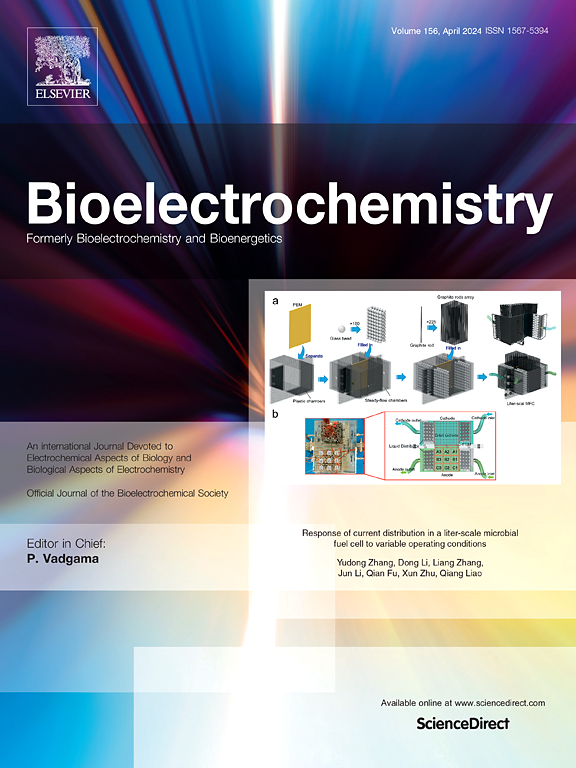Resolving Shewanella vesicular nanowire structure during microbial extracellular electron transfer to a poised electrode
IF 4.5
2区 化学
Q1 BIOCHEMISTRY & MOLECULAR BIOLOGY
引用次数: 0
Abstract
The nanowires of the model electroactive bacterium Shewanella oneidensis have been the subject of numerous studies to elucidate their structure and function. These previous reports have elegantly utilised advanced microscopic techniques to investigate nanowires formed in response to oxygen limitation. However, the detailed structure of nanowires formed on electrodes during extracellular electron transfer has not been reported and it is imperative to determine whether they possess the same vesicular structure that has been reported in the absence of extracellular electron transfer. Using an acetone hexamethyldisilazane dehydration method to preserve soft biological materials, we employed the relatively uncomplicated technique of secondary electron field emission-scanning electron microscopy to visualise the vesicular nanowire structure while attached to an electrode from an operating bioelectrochemical system. Early-stage nanowires appear to consist of intact chains of outer-membrane vesicles forming connections with the electrode surface and with neighbouring cells. Relying on secondary electrons from the inherently conductive carbon felt electrode, sputter coating could be avoided and the delicate structure of the vesicles was preserved with increased detail. The findings inform the fundamental understanding of nanowires during electron transfer and the simple protocol will allow their examination on a variety of existing and emerging electrode materials.

在微生物胞外电子转移到平衡电极过程中,解析希瓦氏菌囊状纳米线结构
模型电活性细菌希瓦氏菌的纳米线已成为许多研究的主题,以阐明其结构和功能。这些先前的报告巧妙地利用了先进的显微技术来研究在氧气限制下形成的纳米线。然而,在细胞外电子转移过程中在电极上形成的纳米线的详细结构尚未报道,因此确定它们是否具有与没有细胞外电子转移时相同的囊泡结构是必要的。利用丙酮六甲基二矽氮烷脱水法保存软生物材料,我们采用相对简单的二次电子场发射扫描电子显微镜技术来观察附着在运行的生物电化学系统电极上的囊状纳米线结构。早期的纳米线似乎由完整的外膜囊泡链组成,这些囊泡链与电极表面和邻近细胞形成连接。依靠固有导电碳毡电极的二次电子,可以避免溅射涂层,并且更加详细地保留了囊泡的精致结构。这些发现为电子转移过程中纳米线的基本理解提供了信息,简单的协议将允许他们在各种现有和新兴电极材料上进行检查。
本文章由计算机程序翻译,如有差异,请以英文原文为准。
求助全文
约1分钟内获得全文
求助全文
来源期刊

Bioelectrochemistry
生物-电化学
CiteScore
9.10
自引率
6.00%
发文量
238
审稿时长
38 days
期刊介绍:
An International Journal Devoted to Electrochemical Aspects of Biology and Biological Aspects of Electrochemistry
Bioelectrochemistry is an international journal devoted to electrochemical principles in biology and biological aspects of electrochemistry. It publishes experimental and theoretical papers dealing with the electrochemical aspects of:
• Electrified interfaces (electric double layers, adsorption, electron transfer, protein electrochemistry, basic principles of biosensors, biosensor interfaces and bio-nanosensor design and construction.
• Electric and magnetic field effects (field-dependent processes, field interactions with molecules, intramolecular field effects, sensory systems for electric and magnetic fields, molecular and cellular mechanisms)
• Bioenergetics and signal transduction (energy conversion, photosynthetic and visual membranes)
• Biomembranes and model membranes (thermodynamics and mechanics, membrane transport, electroporation, fusion and insertion)
• Electrochemical applications in medicine and biotechnology (drug delivery and gene transfer to cells and tissues, iontophoresis, skin electroporation, injury and repair).
• Organization and use of arrays in-vitro and in-vivo, including as part of feedback control.
• Electrochemical interrogation of biofilms as generated by microorganisms and tissue reaction associated with medical implants.
 求助内容:
求助内容: 应助结果提醒方式:
应助结果提醒方式:


